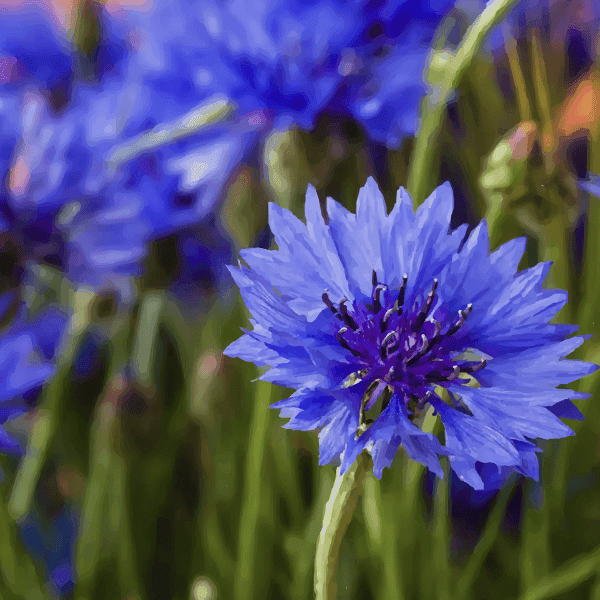
Cornflower Blue Petals {Organic}
Blue Cornflower is found in almost every part of the United States. It is commonly found around corn fields but has nothing to do with the corn itself. Cornflowers are high in antioxidants and anti-inflammatory agents and can even help your tired eyes. It is most often found in teas and toners.
You might need Blue Cornflower if . . .
Do you know that slight burning in your eyes when you know you have been using your phone way too long? Do you feel bloated after eating? Do you have general pain with no specific injury? If any of these things sound familiar, consider trying cornflower.
Cornflower can help those that:
- Suffer from eye strain
- Get frequent indigestion
- Feel bloated or have other digestive problems
- Have general joint pain
- Have sensitive skin
Benefits of cornflower:
Cornflower is sometimes described as an adjuvant herb. This simply means an herb that enhances the effects of other herbs. This is not at all to say that cornflower is a weak herb or without its own benefits. However, you won’t normally see this beautiful flower as the star of an herbal preparation. With its anti-inflammatory and soothing properties, cornflower has an amazing ability to really make other herbs shine. Cornflowers also seem to have a particular affinity for the eyes.
Antioxidants: Cornflowers contain several different types of antioxidants. You can see the anthocyanin in the blue blooms. Anthocyanin is a pigment, the same type of antioxidant that gives blueberries the color of their skin. Cornflowers also have phenolic acids, flavonoids, and some other types of antioxidants. Having antioxidants in your diet can help your body stay healthy and efficient at a cellular level.
Anti-inflammatory: The antioxidants in cornflower are also naturally anti-inflammatory. Cornflower petals also contain other anti-inflammatory compounds like triterpenoids, sesquiterpenes, and monoterpenes. These compounds are extremely common in plants. They are essential parts of a plant’s natural defense system. When consumed by people, they offer anti-inflammatory benefits.
Soothes tired eyes: Cornflower has been traditionally used to soothe all types of eye issues. The exact way that cornflower helps eyes is still largely unknown. Obviously, its anti-inflammatory properties play a part. People have long touted cornflower’s cooling and soothing properties for eye health, both from making it as a tea and ingesting it and from applying an herbal preparation topically to the area around the eyes.
Soothes irritated skin: Cornflower has been shown to reduce inflammation of the skin, particularly helpful for those with sensitive skin (1).
Common ways to use cornflower:
Tea: You can make a simple herbal tea with cornflower by steeping 1 tablespoon of dried cornflower petals in 8 ounces of boiling water for at least 15 minutes. You can sweeten it with raw honey to taste.
Toner: One of the easiest ways to bring the benefits of cornflower to your skin is to make what is essentially a strong tea and preserve it with alcohol or witch hazel extract. Boil 2 cups of water and then pour over ½ cup of dried cornflower in a container that has a lid. Let it sit for at least one hour. Strain the cornflower out and mix in a spray jar with ½ cup of vodka or witch hazel extract.
Growing and Foraging Information
Cornflower can be found growing in almost every part of the United States. The name cornflower comes from a common location where it grows and is easily spotted because of its color. Cornflowers are frequently seen growing along the perimeter of corn fields. There is no botanical relation to corn itself. Cornflowers are also commonly referred to as bachelor's buttons. They are most commonly blue when found in the wild in the United States. There are seeds readily available to grow various shades of pinks, blues, and purples. The blue cornflower is typically used in herbal preparations. Cornflowers are relatively easy to forage for and can be found growing wild in fields. Make sure to forage safely and in accordance with state laws. Do not forage for cornflowers near a roadside, as they may contain some of the pollutants from car exhaust.
Safety Concerns
Cornflower is generally regarded as safe for most people. It has a history of human use for several thousand years. It even is included in a myth about Achilles. A healing centaur (you might notice this is where the scientific name centaurea comes from) named Chiron gave Achilles cornflower to try to help him recover from a wound from a poisonous arrow. It was used by Ancient Romans and Greeks as a medicinal herb and became very prevalent throughout Europe.
Drug Interaction: If you are taking any prescription medications, it is important to always consult with the prescriber before adding any herbs to your diet.
Breastfeeding and Pregnancy: There are no known contraindications for breastfeeding and pregnancy.
Other Concerns: Cornflower is extremely safe when consumed in moderation. With any food, there is always the possibility of an allergy.
Select Studies About Cornflower
How cornflower reduces inflammation in skin
This study explores how exactly cornflower can reduce inflammation of skin. It describes the ways that cornflower neutralizes inflammation and also inhibits inflammatory elements from attaching to receptors to cause inflammation.